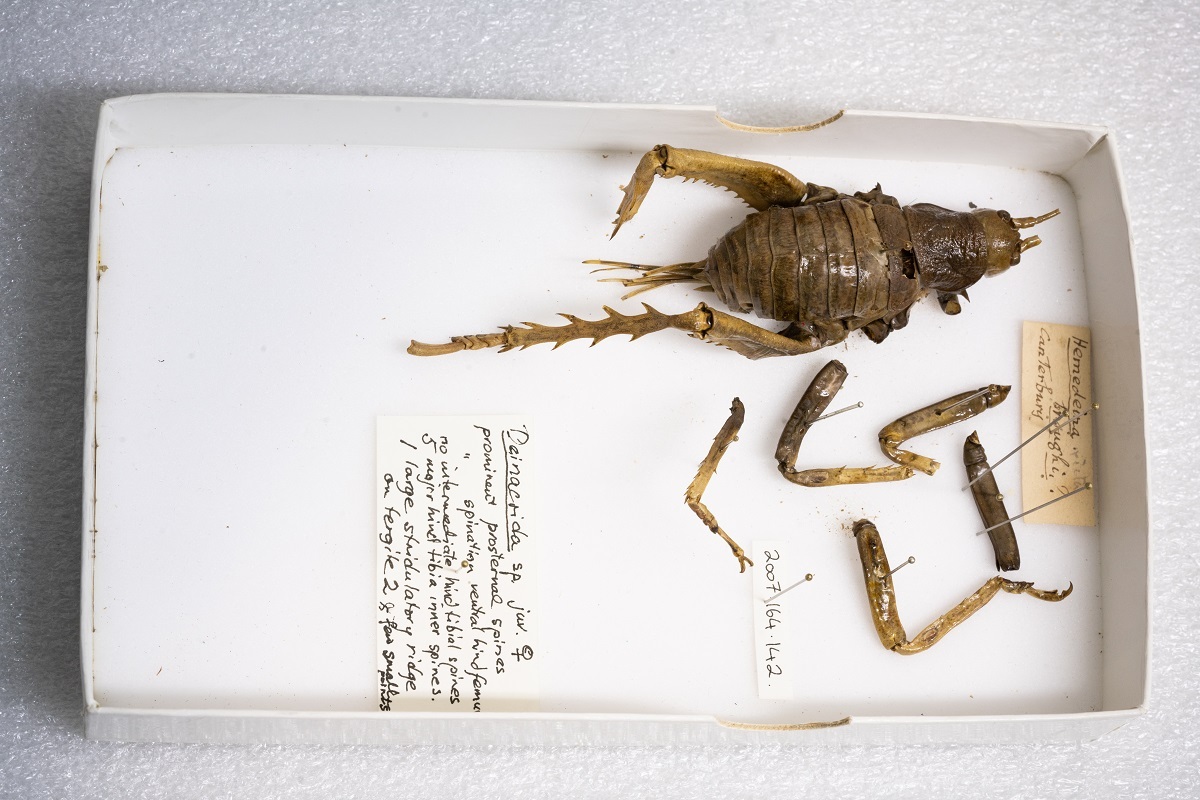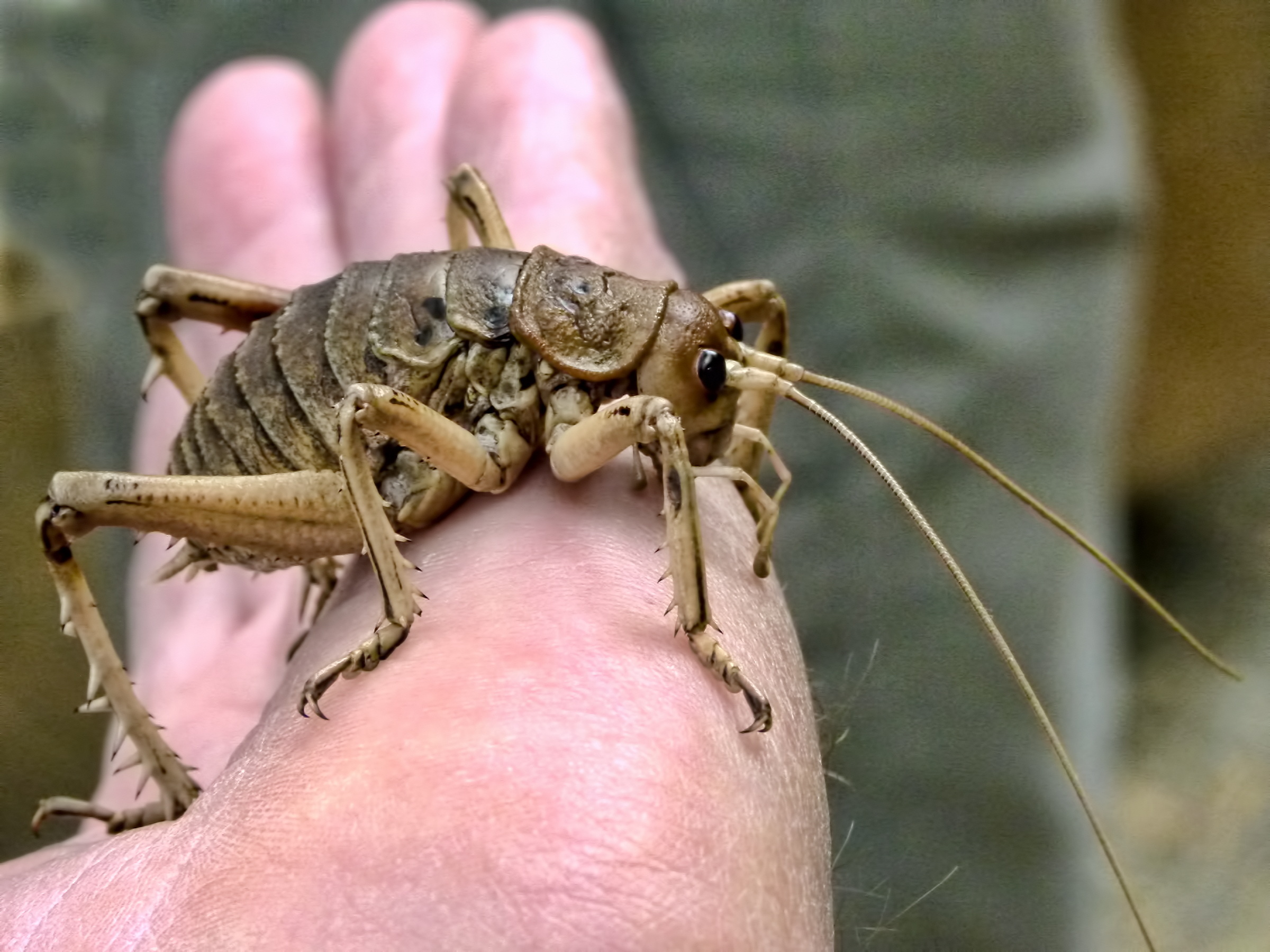The enigmatic wētā are one of Aotearoa New Zealand’s most iconic insects. They tend to elicit a range of reactions from people, from fascination to fear.
New Zealand has over 100 described species of wētā, which are divided into five main groups: tree wētā, ground wētā, cave wētā, giant wētā and tusked wētā. Canterbury Museum cares for over 5,000 wētā specimens, which are either stored as dry pinned specimens or preserved in ethanol.
Most of our wētā specimens are identified with a species name, but one of the unidentified specimens, currently known as the Canterbury giant wētā, is particularly fascinating. It might be the only known specimen of an as-yet-undescribed species.

We don't know much about our Canterbury giant wētā. Its original collecting label only tells us an incorrect species name (Hemideina broughi) and that it was collected in Canterbury. Professor Frederick Wollaston Hutton is most likely the person who collected it, as the label is in his handwriting, but he may also have received it from an unknown source.
Hutton was the Acting Curator at Canterbury Museum between September 1887 and December 1888 and Museum Curator from May 1892 to October 1905. Given that Hutton researched insects, including wētā, the specimen most likely arrived at the Museum during his tenure.
Canterbury Museum Research Fellow and invertebrate zoologist Peter Johns has researched Hutton's collecting expeditions. One report references a trip by Hutton to Mount Captain, which is part of the Hanmer Range near Hanmer Springs. During this trip Hutton climbed Mount Captain on his horse (fittingly also called Captain), collecting a range of wildlife.

Johns, who has an extensive knowledge of wētā biology and taxonomy, thinks the Mount Captain site could potentially be the place the Canterbury giant wētā specimen was collected. The habitat is similar to where other giant wētā species are found, but unfortunately we will never know for certain whether this is right location.
Johns has attempted to identify this wētā. Based on its physical characteristics, he has been able to ascertain that the specimen is in the genus Deinacrida and describe some important features. The specimen is a female, as it has an ovipositor. Female wētā use their ovipositor to lay the eggs of their offspring. An ovipositor allows a female wētā to penetrate surfaces such as soil, wood or crevices. This can protect the eggs from predation and drying out. One reason this female has not been formally given a species name is because she is a sub-adult. This means her ovipositor and other key diagnostic features are not fully developed.
No other specimens that look like this one have ever been collected. Taxonomic research has not been able to clearly distinguish whether our Canterbury giant wētā is a unique species that is extinct, or an immature specimen of a species we already know about. Without the opportunity to examine other mature specimens, it is very difficult to identify this specimen further. Difficult, but hopefully not impossible as the specimen may contain some helpful evidence inside its body.

All living organisms have a unique blueprint of deoxyribonucleic acid (DNA), which essentially lays out how an individual looks and behaves.
DNA barcoding is a technology that allows researchers to extract DNA sequences from different organisms, then compare the sequences between them. Researchers from Manaaki Whenua Landcare Research are attempting to extract DNA from our Canterbury giant wētā specimen. If DNA can successfully be extracted, then it can be compared to the DNA sequences of other giant wētā species. The results of this analysis could shed light on the mystery surrounding this specimen. We'll be sure to let everyone know if DNA barcoding is able to solve the mystery of the Canterbury giant wētā.
But why does any of this matter? Before humans arrived in Aotearoa New Zealand, the Canterbury giant wētā was most likely widely distributed, like many other animals and plants. It probably was found throughout Canterbury. But due to habitat loss and introduction of pest mammals, insect populations have been greatly reduced or even driven to extinction. Giant wētā populations have been reduced to critically low numbers. Fenced ecosantuaries, very isolated patches of habitat or offshore islands are the only place they can live and sustain populations safely.
Museum collections allow us to look to the past and gather information that explains what we have and where we have it. From this we can figure out what we need to do in the future to protect and conserve rare and enigmatic species such as the giant wētā.





